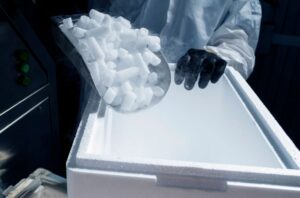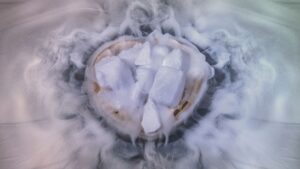When keeping items colder than cold, people usually turn to either liquid nitrogen or dry ice. But what are the differences between dry ice and liquid nitrogen?
Dry ice and liquid nitrogen have many differences. Dry ice isn't as cold as liquid nitrogen, as liquid nitrogen is -320ºF/-196ºC vs dry ice at −109.2°F/-78.5ºC. Dry ice comes in solid form and turns directly into gas, whereas liquid nitrogen is in a liquid state and turns directly into gas at room temperature.
Below is a comparison table showing some of the major differences between dry ice and liquid nitrogen.
| Dry Ice | Liquid Nitrogen | |
|---|---|---|
| Temperature | ||
| Form | Solid | Liquid |
| Turns Into: | Gas | Gas |
| Storage: | In foam coolers | In vented vacuum insulated flasks |
| Price: | $1-$3/pound (details) | $0.50-$2/gallon $0.13-$0.50/liter |
| Where To Buy: | Local supermarket | Specialty suppliers |
| How is it made | Depressurizing CO2 (details) | Compressing air (details) |
| Common uses: | Food and medicinal cold storage | Cryopreservation of cells and microbes |
There are many differences between dry ice and liquid nitrogen, but one of the main differences is how they are used, as they are used in very different ways. To learn more about these products and how they are used, keep reading.
Dry Ice
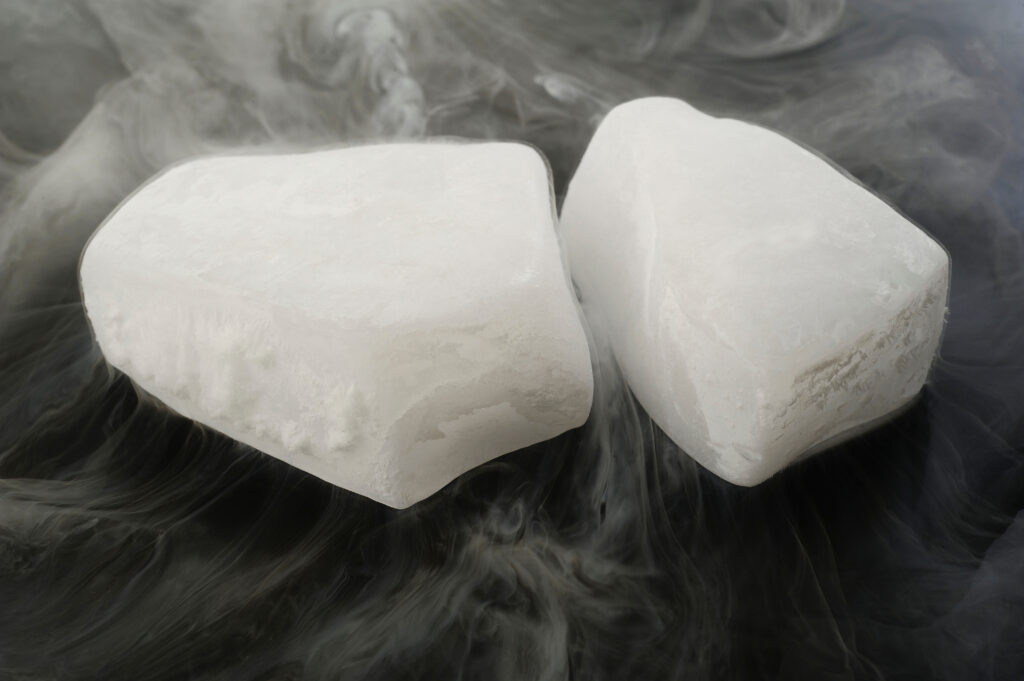
Dry ice is frozen carbon dioxide and has a fixed temperature of −109.2°F/-78.5ºC at sea level.
The fixed temperature is a result of the fact that dry ice is a solid that turns directly into a gas at 1 atmospheric pressure. This phase change keeps the frozen carbon dioxide at −109.2°F/-78.5ºC until it has all sublimated away into gas.
Dry ice is sold in blocks or chunks and is often used during the Halloween season as the smoke adds a wonderful effect and adds to any spooky atmosphere. Click here to learn more about dry ice fogs in drinks.
Dry ice is often used to keep drinks cold as well as in the entertainment industry. People might add it to a fog machine as the dry ice creates fog when combined with a liquid. Dry ice fog will last as long as there is dry ice left and warm liquid.
Dry ice is made by taking carbon dioxide (usually waste from commercial processes) and compressing it into a liquid form then decompressing it quickly, radically dropping the temperature and forming dry ice.
At 5.1 atm (atmospheres) carbon dioxide will turn from a gas into a liquid (source). This gas is then decompressed when it is moved from a high pressure environment to a low pressure environment. A lot of the liquid turns into gas cooling it down quickly and turning it into dry ice snow.
This snow is then compressed and turned into the dry ice blocks or pellets we are familiar with.

Dry ice is extremely dangerous because it can cause asphyxiation and frostbite. It can cause frostbite almost immediately if you touch it, which is why you need to wear protective equipment when handling dry ice.
If kept in a small room where there is no ventilation system, it can cause asphyxiation. Carbon dioxide will fill the air rather than oxygen. You must manage and dispose of dry ice safely to ensure no one gets hurt.
If you start feeling dizzy, develop a sore throat, have shortness of breath, or start to be confused while in a room with dry ice, open the windows and move to another room with better ventilation.
Dry ice can be found at many grocery stores during the Halloween season. It costs between $1 to $3, so it is relatively cheap and you can buy dry ice from Walmart or other supermarkets like Publix, HEB or Meijer.
If you need it before Halloween, you have to find a distributor and have it delivered to your home. When you purchase dry ice, sometimes you will have to sign a waiver that says you know the risks of using dry ice.
Liquid Nitrogen
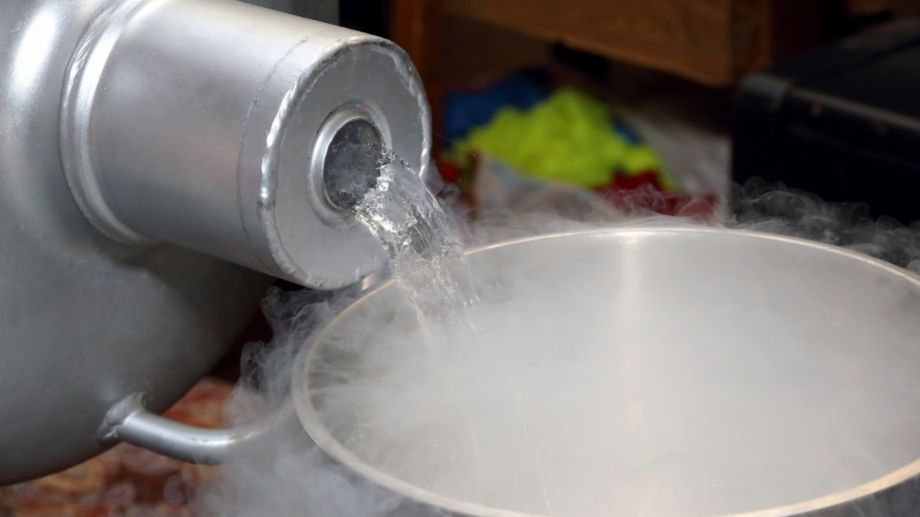
Liquid nitrogen is extremely cold at a temperature of -320ºF/-196ºC, so it is much colder than dry ice. Because of its extremely cold temperature, it is dangerous to handle. When liquid nitrogen reaches -320ºF/-196ºC it starts to boil (or turn into a gas).
Liquid nitrogen is distributed in heavy-duty vacuum insulated flasks that can keep the cold material contained. The flasks are vented so excess gas can escape, otherwise the pressure would build up so high the flask would explode. It is hard to keep it contained and can extremely dangerous to handle.
Liquid nitrogen is mainly sold to scientific institutions and manufacturers of items that keep food cold. Some specialty shops use liquid nitrogen to make ice cream, but their employees go through extensive training before they are allowed to use the liquid nitrogen machines. The liquid nitrogen doesn't affect the taste of the ice cream because it is odorless and colorless.
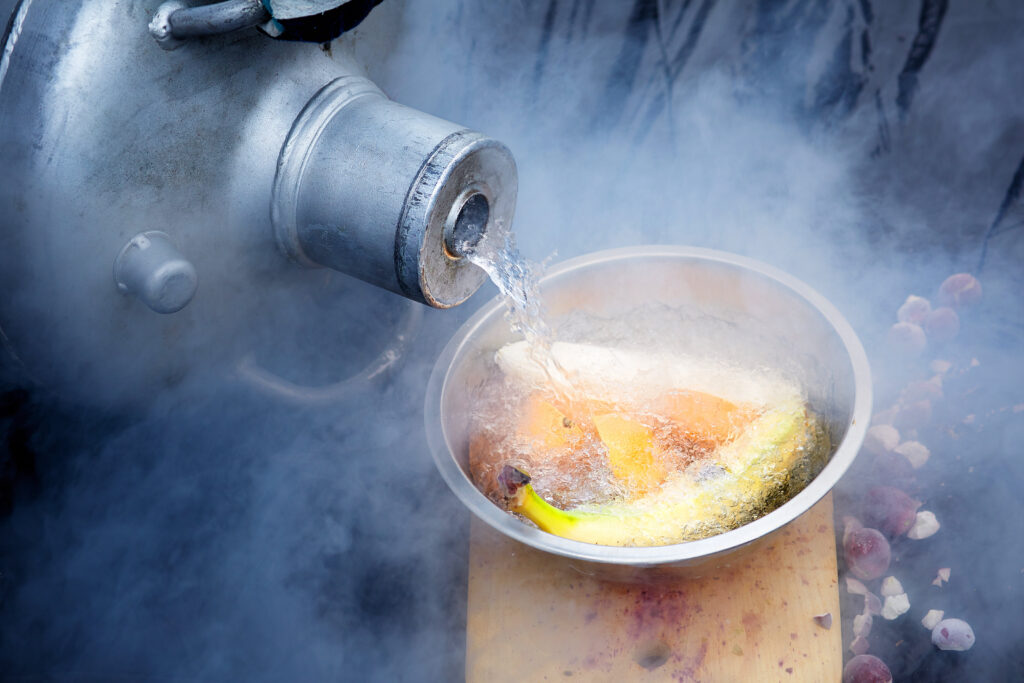
If you touch liquid nitrogen, your skin will burn or become damaged within seconds. When handling liquid nitrogen, wear protective gear and be extremely careful.
Differences Between Dry Ice and Nitrogen
Liquid nitrogen and dry ice are very different. First of all, one is a liquid and the other is solid.
Dry ice is easy to find in local stores and can be purchased nearly everywhere. You sometimes have to sign a waiver, but otherwise, it is extremely easy to purchase dry ice.
The opposite is the case for liquid nitrogen. It can be tricky to find purchasable liquid nitrogen and you have to sign an extensive waiver before you are allowed to purchase it.
Liquid nitrogen can actually be cheaper than dry ice at as low as $0.50/gallon (3.785 liters) vs $1-$3/pound (0.45 kgs). This is because the air we breathe is full of nitrogen and it makes up 78% of our atmosphere. This means making liquid nitrogen is easy with the right equipment whereas dry ice is made from carbon dioxide and needs to be acquired as a waste product from other companies.
Below you can see liquid nitrogen being made at home:
Dry ice and liquid nitrogen are made of different materials. Dry ice is made of carbon dioxide, while liquid nitrogen is made of nitrogen.
Dry ice and liquid nitrogen are both used to keep foods cold, but liquid nitrogen is often used to flash freeze items while dry ice is used to keep food and drinks cold when machines can't be used. For example, many companies use dry ice to keep frozen foods cold when transporting them to grocery stores. Learn how long dry ice lasts for shipping.
Liquid nitrogen is also used to keep specimens that are being sent to laboratories cold. It is mainly used to keep biological specimens cold so they don't deteriorate before they reach the lab and are tested. However, dry ice is also sometimes used, but liquid nitrogen is used more often than dry ice.
Dry ice is more well-known than liquid nitrogen because it is so common. People enjoy using it because of the smokey effects. However, liquid nitrogen can also give a scene similar smokey effects. However, since liquid nitrogen is hard to get and is harder to handle, so dry ice is used more often.
Although dry ice is easy to find at grocery stores, some grocery stores don't carry dry ice. Call beforehand to determine if your local grocery store sells dry ice. For example, winco sells dry ice all year round, whereas only some Ralphs stores stock dry ice.
Overall, there are many differences between dry ice and liquid nitrogen. However, they are both interesting materials that need to be handled with caution and care. Before you purchase liquid nitrogen or dry ice, make sure you have the materials needed to protect yourself and those around you from the harmful effects should you come into contact with either material.



